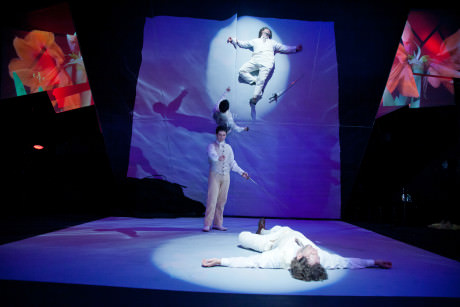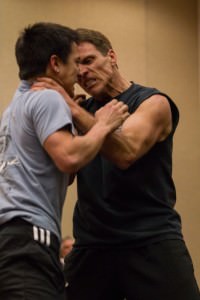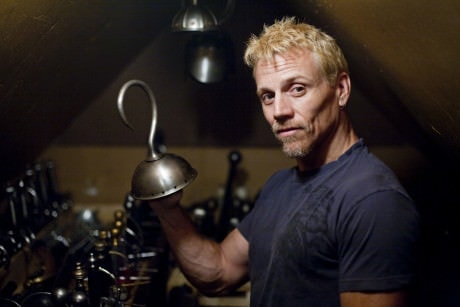As I strolled into the Smithsonian’s S. Dillon Ripley Center (shared with the Sackler Museum of Asian Art and the National Museum of African Art), I was surprised to see over 100 people eagerly awaiting the start of the class En Garde! The Art of Fight Choreography.

We certainly didn’t have long to wait; the two speakers Robb Hunter and Craig Lawrence introduced themselves at exactly 6:30 PM and then quickly left to take a phone call. It was a ruse; they re-entered the classroom seconds later in combat rolling in on the floor and crawling over each other while violently exchanging punches. As we all sat totally mesmerized, I soon realized that there was no blood and neither of the two seemed to be black and blue or in pain. The cardinal fight choreography rule is – “Illusion of physical combat appears real, but no REAL physical damage results.” Be it gymnastics, swordplay, fencing, gladiatorial combat or multiple martial arts (Jiu jitsu, karate, judo, tae kwon do, kendo aikido, etc.), they are all the rainbow of options available to enliven the action, and capture the audience’s imagination in either world of stage or screen.
Specific combat skills that might be seen on stage include, but are certainly not limited to, slaps, grappling, punches, kicks, wrestling and throwing/holding techniques. Of course, the primary and most important concern in theater is safety,both for the actors and the audience. One mechanism that helps ensure a flawless and safe performance, anytime stage combat is utilized in a live production, is a “fight call.” A fight call is essentially a brief rehearsal before every performance in order to continually reinforce the fight choreography in the actors’ bodies and memories.
‘Knaps’ are another “trick of the trade” that play an important role in a successful fight. A ‘Knap’ is the sound you hear when an actor lands a simulated punch or kick to his partner. Strikes to the face, for example, never really make contact so the actors must use their hands and bodies to make this sound creating a believable moment for the audience. Sometimes clothes are especially chosen to aid in producing such sounds. Special padding can also be worn by combatants to ensure that the actors are as well protected as possible. Robb passed around a hex pad shirt which provides low profile padding for sensitive areas, which are available at a local sporting goods store for $64.91- as the price tag was still on the item.
This kind of theatrical rockem/sockem has always amazed me. I had no idea that the Society of American Fight Directors (SAFD) was established in 1977 for U.S.A. specialty training and certification. Britain, Australia, Canada, and New Zealand have similar programs.

Robb Hunter, the principle speaker for the evening began his career in New York, initially as an actor, and after 10 years moved to DC where he has continued to direct and choreograph (and occasionally perform) for the last 11 years. During the animated lecture, including numerous demos with detailed explanations, he emphasized an important fact…for every 5 seconds of fight seen by the audience, it takes about 1 hour of rehearsal to get the fight up to performance speed…and more rehearsal will most likely be needed for perfection.
Some of his favorite “fight” successes in DC area productions include: Superior Donuts (The Studio Theatre), Piano Lesson (Olney Theatre Center), Ruined (Arena Stage), Carmen (The Kennedy Center), Zombie: The American (Woolly Mammoth Theatre Company), As You Like It, and the upcoming Othello (Shakespeare Theatre Company)
Of all the shows Robb has contributed his expertise, Romeo and Juliet stands out since he has worked on this show many times over the years. Robb is also employed at American University as an Artist in Residence, a teaching assistant for the Shakespeare Theatre Company and The Studio Theatre’s Acting Conservatory.
Robb reminded the audience that in order to be successful in this field, at least as a performer, you must be comfortable being physical with your fellow actors. Also, you must fight safely – keeping in mind the importance of making eye contact with your opponent to indicate readiness as well as following the golden rule of always staying 8-10 inches away from the actual contact point to avoid injury. As they threw darts and used whips on each other, you were subtly reminded of the old axioms…Remember, this is only a movie…the show must go on!
Craig Lawrence, the second presenter, is also a member of SAFD and has always been based in DC initially as an actor and eventually making a career in fight design. His resume is equally impressive in the breadth and depth of productions he has been involved in throughout his career.

For me, what transpired tonight opens up an entire perspective on fight choreography that was never on my radar screen. Next time when you attend a show or movie incorporating these techniques, realize that a lot was of time, energy, and rehearsal went in to making the scene so realistic.
The class lasted two hours.
En Garde! The Art of Fight Choreography was on September 28, 2015 at The S. Dillon Ripley Center. For more information on Smithsonian events check their Smithsonian Associates Program at their website or call their box office at (202) 633-3030.




